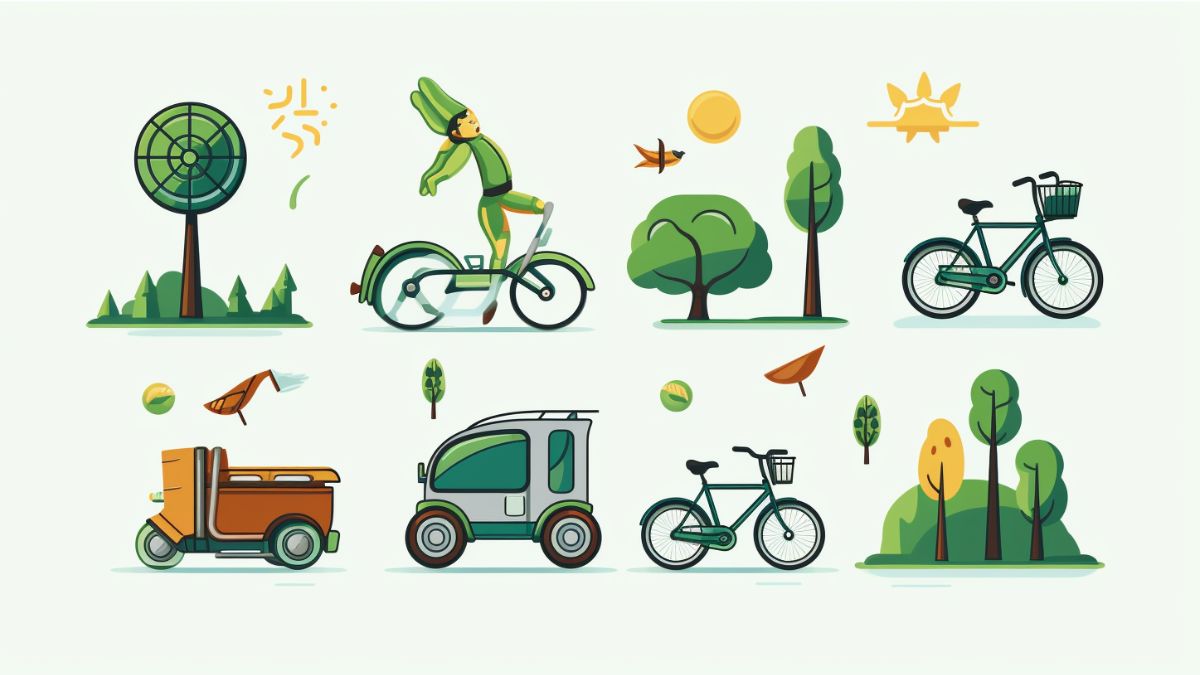If you are seeking ways to make a positive impact on the world and actively contribute to a more sustainable future, look no further than sustainable living innovations. Fortunately, there are plenty of innovative ideas and practices that can help you live sustainably.
By embracing sustainable living, you can reduce your carbon footprint, conserve natural resources, and support a clean and safe planet. From participating in community gardens to using energy-efficient lighting, there are numerous ways to incorporate sustainable living into your daily life.
So, let’s explore these sustainable living innovations and start making a positive impact together.
Key Takeaways
- Sustainable living promotes the practice of reducing demand for natural resources and replacing what is used to the best of one’s ability.
- Community gardens are a great way to promote sustainable living by creating green spaces, supporting healthy soil, reducing carbon emissions in urban areas, and providing an opportunity to grow one’s own food.
- Minimalism encourages maximum purpose for everything owned and used, cutting out unnecessary items and waste materials, emphasizing recycling and mindful consumption, and promoting a simpler and more intentional lifestyle.
- Energy-efficient lighting, such as CFL or natural light sources, reduces demand for energy resources, decreases waste going to landfills, saves money on energy bills, and promotes sustainability and eco-friendly practices.
Emergence of Green Technology in Homes
The emergence of green technology in homes has revolutionized sustainable living. It allows you to reduce your environmental impact while enjoying the convenience of modern amenities.
Sustainable living innovations in the form of smart home technologies, energy-efficient appliances, and renewable energy systems have made it easier than ever to live a self-sustainable lifestyle. By incorporating these sustainable living ideas into your home, you can significantly reduce your carbon footprint and contribute to a cleaner, greener future.
Social innovations for sustainable living, such as community gardens and shared resources, also promote a sense of belonging and cooperation within your community. From energy-efficient lighting to efficient errands and natural cleaners, there are countless ways to embrace sustainable living in your own home and make a positive impact on the environment.
Related Article: Eco-Friendly Kitchen Products: Revolutionary Kitchen for A More Sustainable Lifestyle.
The Impact of Veganism on Sustainability
Consider adopting a vegan lifestyle to reduce your environmental impact and promote sustainability. By choosing to follow a vegan diet, you can contribute to self-sustainable living and make a positive difference in the world.
Research shows that animal agriculture is a major contributor to greenhouse gas emissions, deforestation, and water pollution. By eliminating animal products from your diet, you can help reduce carbon emissions, conserve natural resources, and protect ecosystems.
Additionally, a plant-based diet has been linked to lower rates of chronic diseases and improved overall health. Embracing a vegan lifestyle not only benefits the environment but also promotes a sense of belonging to a community of individuals who prioritize sustainable living.
Start making conscious choices today and live self-sustainably by adopting a vegan lifestyle.
Zero-Waste Lifestyle: A New Trend
Embracing a zero-waste lifestyle means making conscious choices to reduce waste and minimize our environmental impact. Here are three ways you can incorporate a zero-waste mindset into your daily life:
- Adopt reusable alternatives: Swap out single-use items like plastic bags, straws, and water bottles for reusable options. Invest in a durable water bottle and bring your own shopping bags and utensils when you’re out and about.
- Practice mindful consumption: Before making a purchase, consider if you really need the item and if it aligns with your values. Choose products with minimal packaging and opt for second-hand or locally made goods whenever possible.
- Compost and recycle: Set up a compost bin in your backyard or look for community composting programs. Learn about your local recycling guidelines and make sure you’re recycling correctly. By diverting organic waste from landfill and properly recycling materials, you can significantly reduce your waste footprint.
Instead of discarding or purchasing new ones, you can recycle or refurbish your old batteries, restoring them to their original state. Click here to discover how and let’s make a difference together!
The Power of Solar Energy
Solar energy is a renewable source that harnesses the power of the sun to generate electricity. By capturing the sun’s rays through photovoltaic panels, solar energy can be converted into usable electricity. This innovative technology offers numerous benefits for sustainable living.
Solar energy is abundant and widely available, making it a reliable source of power. It produces no greenhouse gas emissions or air pollution, helping to reduce our carbon footprint and combat climate change. Additionally, solar energy systems require minimal maintenance and can provide long-term cost savings on energy bills.
Embracing solar energy not only promotes a clean and sustainable future, but also allows individuals to actively participate in the transition towards renewable energy sources. By harnessing the power of the sun, you can contribute to a more sustainable and eco-friendly world.
Related Article: A Brief Guide To Installing Solar Power In Your Home.
The Role of Electric Vehicles in Sustainable Living
If you’re looking to reduce your carbon footprint and embrace eco-friendly transportation, electric vehicles can play a significant role in promoting sustainable practices. Here are three reasons why electric vehicles are an important part of sustainable living:
- Environmental Impact: Electric vehicles produce zero tailpipe emissions, reducing air pollution and greenhouse gas emissions. By switching to an electric vehicle, you can help combat climate change and improve air quality in your community.
- Energy Efficiency: Electric vehicles are more energy-efficient than internal combustion engine vehicles. They convert a higher percentage of the energy stored in their batteries to power the wheels, resulting in less energy waste and lower fuel costs.
- Renewable Energy Integration: Electric vehicles can be charged using renewable energy sources like solar or wind power. By utilizing clean energy to charge your electric vehicle, you can further reduce your environmental impact and support the transition to a sustainable energy system.
Related Article: Shining A Light On Solar: Benefits, Costs & Incentives.
Water Conservation Techniques for Homes
Water conservation techniques for homes can help reduce water waste and promote more efficient use of this valuable resource. There are several simple yet effective strategies you can implement to conserve water in your home. First, fix any leaks in faucets, toilets, and pipes, as even small leaks can waste significant amounts of water over time.
Additionally, installing low-flow fixtures, such as showerheads and faucets, can significantly reduce water usage without sacrificing performance. Another technique is to collect and reuse rainwater for purposes like watering plants or cleaning. Finally, being mindful of your water usage habits, such as taking shorter showers and only running the dishwasher and washing machine with full loads, can make a big difference in conserving water.
The Importance of Sustainable Farming
One crucial aspect of sustainable farming is the use of organic fertilizers and pesticides. These alternatives to synthetic chemicals support the health of the soil, plants, and surrounding ecosystems.
Using organic fertilizers nourishes the soil with essential nutrients, improving its fertility and structure. Additionally, organic pesticides derived from natural sources, such as plant extracts or beneficial insects, target specific pests while minimizing harm to beneficial organisms. This approach promotes a balanced and resilient agricultural system, reducing the need for chemical inputs and protecting the environment.
The Influence of Minimalism on Sustainable Living
When it comes to embracing minimalism, you can make a significant impact on your sustainable lifestyle by decluttering and focusing on what truly matters.
Minimalism promotes a simpler and more intentional lifestyle, supporting sustainability and reducing environmental impact. By cutting out unnecessary items and waste materials, you ensure maximum purpose for everything you own and use. This approach emphasizes recycling and mindful consumption, reducing the demand for new products and minimizing waste.
By embracing minimalism, you not only create a more organized and peaceful living space, but also contribute to a cleaner and safer planet. It’s about prioritizing quality over quantity and finding contentment in owning less.
Related Article: Eco-Friendly Kitchen: How To Design A Sustainable Dream Kitchen.
The Revolution of Sustainable Fashion
Now let’s shift our focus to the revolution of sustainable fashion. Sustainable fashion is a movement that aims to minimize the negative impacts of the fashion industry on the environment and society. Here are three key aspects of sustainable fashion:
- Ethical Production: Sustainable fashion promotes fair and safe working conditions for garment workers. It emphasizes transparency and accountability throughout the supply chain, ensuring that workers are paid fair wages and have access to safe working environments.
- Eco-friendly Materials: Sustainable fashion encourages the use of organic, recycled, and biodegradable materials. These materials reduce the consumption of non-renewable resources and minimize the release of harmful chemicals into the environment.
- Circular Economy: Sustainable fashion embraces the concept of a circular economy, where garments are designed to be reused, repaired, or recycled at the end of their life cycle. This approach reduces waste and encourages a more sustainable and responsible approach to fashion consumption.
The Rise of Eco-Tourism
Eco-tourism has gained significant popularity in recent years as travelers seek sustainable and environmentally friendly ways to explore new destinations. This trend is driven by a growing awareness of the importance of preserving natural resources and protecting the environment.
Eco-tourism offers travelers the opportunity to experience the beauty of nature while minimizing their impact on the ecosystem. By choosing eco-friendly accommodations, participating in outdoor activities that promote conservation, and supporting local communities, eco-tourists can contribute to the preservation of natural habitats and cultural heritage.
This form of travel not only allows individuals to connect with nature on a deeper level but also fosters a sense of belonging to a global community of like-minded individuals who prioritize sustainability. As the demand for eco-tourism continues to rise, it is crucial for destinations and travelers alike to prioritize sustainable practices and work together to protect our planet.
Incorporating Sustainability in Education
You can incorporate sustainability in education by teaching students about the importance of environmental conservation and providing them with opportunities to engage in hands-on activities that promote sustainable practices.
- Integrate sustainability into the curriculum: Incorporate topics such as climate change, renewable energy, and waste reduction into various subjects, including science, social studies, and even art. This interdisciplinary approach helps students understand the interconnectedness of sustainability and fosters a sense of responsibility towards the environment.
- Create sustainable learning environments: Implement eco-friendly practices within the school, such as recycling programs, energy-efficient lighting, and water conservation initiatives. By making sustainability a visible part of the school environment, students are more likely to internalize its importance and incorporate it into their own lives.
- Encourage student-led initiatives: Empower students to take the lead in sustainability projects, such as starting a school garden, organizing clean-up campaigns, or advocating for sustainable policies. This allows them to develop leadership skills, critical thinking, and a sense of agency in creating a more sustainable future.
The Effect of Composting on the Environment
Start composting at home to reduce food waste and create nutrient-rich soil that benefits the environment. Composting is a sustainable practice that diverts organic waste from landfills, reducing greenhouse gas emissions. By composting food scraps and yard waste, you can contribute to the production of nutrient-rich soil that improves soil health and supports plant growth.
Composting is a simple process that involves layering organic materials such as fruit and vegetable scraps, coffee grounds, and yard trimmings. These materials break down over time, with the help of microorganisms, into a dark, crumbly substance known as compost. This compost can then be used as a natural fertilizer for your garden or potted plants.
By composting, you not only reduce the amount of waste sent to landfills but also decrease the need for chemical fertilizers and pesticides. Additionally, composting helps retain moisture in the soil, reduces erosion, and improves soil structure. It is a win-win situation for both the environment and your garden.
The Transition to Renewable Energy
The transition to renewable energy is essential for reducing greenhouse gas emissions and mitigating the effects of climate change. Here are three reasons why embracing renewable energy is crucial for a sustainable future:
- Environmental Impact: Renewable energy sources such as solar and wind power produce little to no greenhouse gas emissions, unlike fossil fuels. By shifting to renewable energy, we can significantly reduce our carbon footprint and minimize the negative impact on the environment.
- Energy Independence: Investing in renewable energy allows us to become less reliant on finite resources like coal and oil. By harnessing the power of the sun, wind, and water, we can create a more sustainable and resilient energy system that is not subject to price fluctuations or geopolitical tensions.
- Economic Opportunities: The transition to renewable energy presents a vast array of economic opportunities. Investing in clean energy technologies and infrastructure can create jobs, stimulate economic growth, and foster innovation. It also reduces our dependence on imported energy sources, keeping money within local communities and driving sustainable development.
Related Article: Unlock The Power Of Green Energy: 6 Reasons To Make The Switch.
The Contribution of Green Architecture to Sustainability
Green architecture plays a significant role in promoting sustainability. It incorporates eco-friendly design principles and utilizes renewable materials. The aim is to create buildings that minimize their environmental impact and maximize energy efficiency.
Sustainable design features are a key component of green architecture. These features include passive solar heating, natural ventilation, and efficient insulation. By implementing these features, the need for artificial heating and cooling is reduced.
Another important aspect of green architecture is the use of green roofs and walls. These not only provide insulation but also improve air quality and reduce stormwater runoff. They are a valuable addition to any eco-friendly building.
Incorporating renewable energy sources is another way green architecture promotes sustainability. Solar panels and wind turbines are commonly used to generate electricity. By utilizing these sources, the reliance on fossil fuels is reduced, leading to a cleaner and more sustainable energy system.
Furthermore, green architecture takes into consideration the entire lifecycle of a building. From construction to demolition, efforts are made to ensure minimal waste and maximum resource efficiency. This holistic approach is essential for creating a truly sustainable built environment.
Related Article: Tiny House Made Easy – Building And Designing A Tiny House.
The Importance of Biodiversity in Sustainable Living
Embrace the importance of biodiversity in your sustainable lifestyle by understanding how it supports the health of ecosystems and contributes to a more resilient and balanced natural world.
- Biodiversity enhances ecosystem stability: A diverse range of species within an ecosystem provides a safety net against disturbances and helps maintain ecological balance. Each species plays a unique role, and the loss of even one species can have cascading effects on the entire ecosystem.
- Biodiversity supports ecosystem services: Ecosystems provide us with essential services like clean air, water, and soil fertility. Biodiversity is crucial for the functioning of these services. For example, pollinators such as bees and butterflies are essential for crop production and plant reproduction.
- Biodiversity promotes resilience to environmental changes: Climate change and other environmental pressures are threatening ecosystems worldwide. Biodiversity acts as a buffer against these changes by allowing ecosystems to adapt and recover. It increases the chances of survival for different species and ensures the long-term sustainability of ecosystems.
Conclusion
Embracing sustainable living and its innovations, such as green technology, veganism, zero-waste lifestyles, solar energy, electric vehicles, composting, renewable energy, green architecture, and biodiversity, is like planting a seed of hope for a greener future. By incorporating these sustainable living innovations, you become a symbol of change.
Each action you take, guided by sustainable living innovations, is a step towards a harmonious relationship with the environment. As you reduce your carbon footprint and conserve resources, you become a beacon of sustainability, inspiring others to join the movement. Together, we can create a world where nature thrives, and future generations can flourish through sustainable living innovations.




